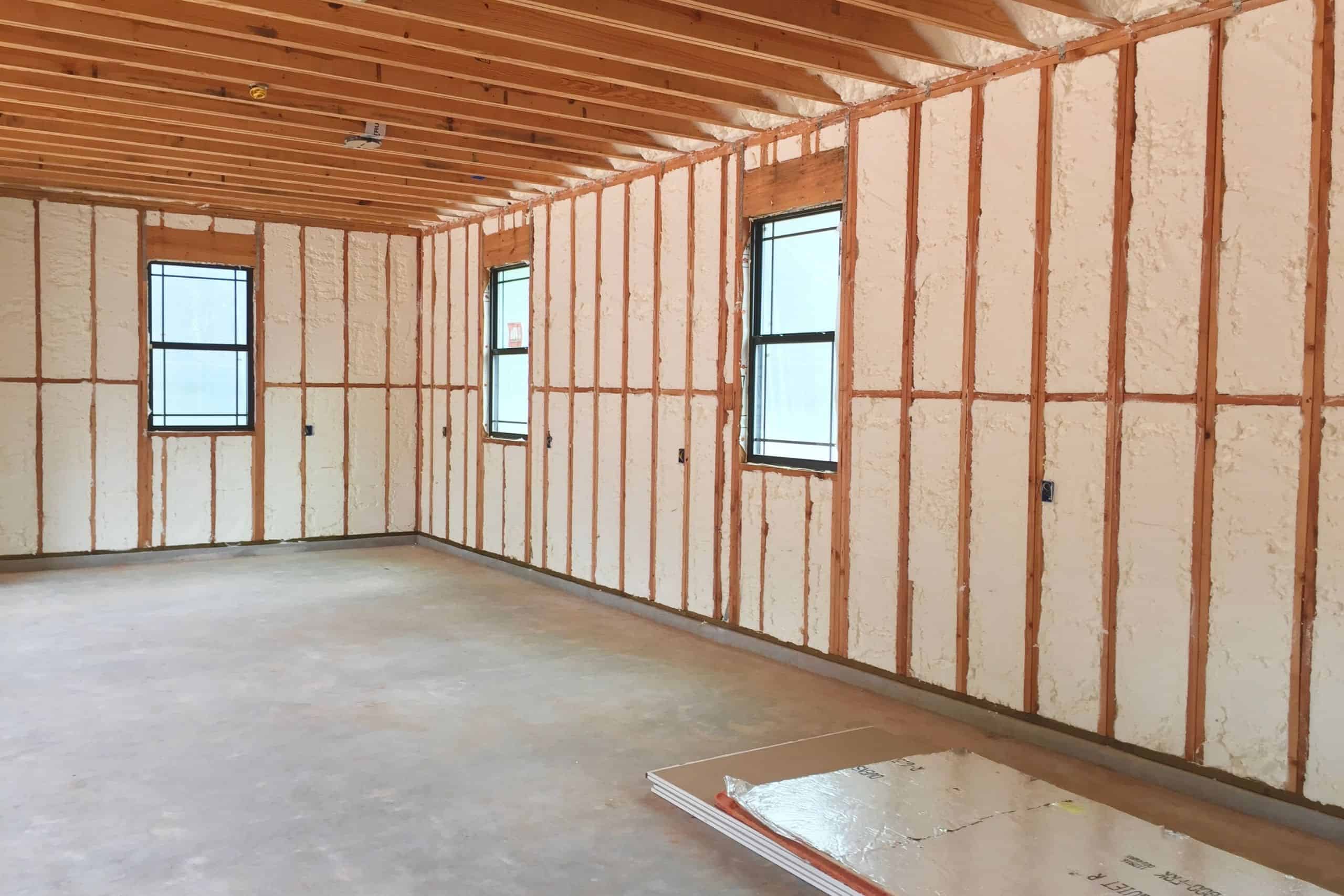Spray foam insulation drives sustainable building practices by delivering superior thermal performance, creating airtight building envelopes, and reducing energy consumption by up to 50% compared to traditional insulation methods. This advanced insulation technology eliminates thermal bridging, prevents air infiltration, and maintains consistent indoor temperatures while significantly lowering heating and cooling demands throughout a building’s lifecycle.
Modern construction increasingly relies on spray foam’s dual functionality as both insulation and air barrier to achieve net-zero energy targets and green building certifications. The material’s ability to seal complex geometries and fill irregular spaces makes it indispensable for high-performance building assemblies that prioritize energy efficiency and environmental responsibility.
Energy Efficiency Performance Analysis
Spray foam insulation transforms building energy profiles through measurable performance improvements. Buildings with spray foam systems typically achieve 40-60% reduction in energy consumption compared to conventional insulation approaches. The seamless application eliminates the air leakage that accounts for 25-40% of heating and cooling losses in standard construction.
Closed-cell spray foam delivers R-values between 6.0-7.0 per inch, while open-cell variants provide R-3.5-4.0 per inch. These thermal resistance values surpass fiberglass batts (R-2.9-3.8) and cellulose (R-3.1-3.8) while simultaneously addressing air infiltration issues that traditional materials cannot resolve.
Thermal Performance Specifications
| Insulation Type | R-Value per Inch | Air Permeability | Moisture Resistance | Structural Enhancement |
| Closed-Cell Spray Foam | 6.0-7.0 | Excellent (0.02 perm) | Superior | Adds structural strength |
| Open-Cell Spray Foam | 3.5-4.0 | Good (16 perm) | Moderate | Minimal structural impact |
| Fiberglass Batts | 2.9-3.8 | Poor | Limited | None |
| Cellulose | 3.1-3.8 | Moderate | Variable | None |
| Mineral Wool | 3.0-3.3 | Moderate | Good | None |
Bonus Tip: Hybrid spray foam systems combining closed-cell and open-cell applications optimize both thermal performance and cost-effectiveness by placing closed-cell foam at critical air sealing locations and open-cell foam in remaining cavity spaces.
Environmental Impact Assessment
Spray foam contributes to sustainable building practices through multiple environmental pathways beyond energy savings. The material’s longevity eliminates replacement cycles common with traditional insulation, reducing waste generation and resource consumption over building lifespans of 50-100 years.
Modern spray foam formulations utilize bio-based polyols derived from renewable resources like soybean oil, reducing petroleum dependency by 15-20%. Water-blown open-cell foams eliminate ozone-depleting blowing agents, while fourth-generation closed-cell formulations achieve global warming potentials below 1.0.
Comparative Environmental Impact Analysis
| Environmental Factor | Spray Foam | Fiberglass | Cellulose | Mineral Wool |
| Embodied Energy (MJ/m²) | 85-95 | 45-55 | 25-35 | 55-65 |
| Carbon Footprint (kg CO₂/m²) | 12-18 | 8-12 | 3-6 | 10-14 |
| Recyclability | Limited | High | High | High |
| Lifespan (years) | 50+ | 20-30 | 20-40 | 30-50 |
| Bio-content Potential | 15-25% | 0% | 85-100% | 0% |
Market data indicates spray foam installations have grown 300% since 2010, with 65% of new commercial construction incorporating spray foam systems for energy code compliance and sustainability certifications.
Green Building Certification Integration
Spray foam systems directly contribute to LEED, ENERGY STAR, and Passive House certification requirements through measurable performance criteria. The material’s air sealing capabilities help achieve blower door test requirements below 3.0 ACH50 for high-performance buildings and 0.6 ACH50 for Passive House standards.
LEED v4 credits for spray foam applications include Energy and Atmosphere optimization (up to 18 points), Indoor Environmental Quality improvements (up to 16 points), and Materials and Resources credits for bio-based content (up to 4 points). Buildings with comprehensive spray foam systems typically achieve 15-25% higher LEED scores than comparable structures with conventional insulation.
Bonus Tip: Spray foam’s contribution to indoor air quality improvements often qualifies for additional LEED credits through reduced volatile organic compound emissions and enhanced moisture control.
Cost-Benefit Analysis for Sustainable Construction
Initial spray foam insulation costs range from $3.50-$6.50 per square foot, representing 150-200% premium over fiberglass systems. However, lifecycle cost analysis reveals positive returns within 3-7 years through energy savings, reduced HVAC equipment sizing, and eliminated air sealing labor.
Economic Performance Comparison
| Cost Factor | Spray Foam | Traditional Insulation + Air Sealing |
| Initial Installation ($/sq ft) | $3.50-$6.50 | $2.50-$4.00 |
| Annual Energy Savings | $0.75-$1.25/sq ft | $0.15-$0.35/sq ft |
| HVAC Equipment Reduction | 15-25% | 0-5% |
| Maintenance Requirements | Minimal | Moderate to High |
| Payback Period | 3-7 years | 8-15 years |
Buildings with spray foam systems command 8-12% higher resale values and achieve 15-20% faster sale times due to documented energy performance and comfort improvements. Installation Considerations for Optimal Performance
Installation Considerations for Optimal Performance
Successful spray foam applications require specific environmental conditions and professional expertise. Installation temperatures must remain between 60-90°F with relative humidity below 85% for proper chemical reactions and foam expansion. Surface preparation includes cleaning, priming porous substrates, and ensuring adequate ventilation during application.
Quality control measures include thickness verification, density testing, and thermal imaging to identify potential gaps or inconsistencies. Third-party inspections verify compliance with building codes and manufacturer specifications, particularly for fire safety ratings and vapor permeability requirements.
Bonus Tip: Scheduling spray foam insulation during moderate weather conditions optimizes cure times and reduces the risk of application defects that compromise long-term performance.
Things to Consider Before Making a Decision
Climate zone requirements significantly influence spray foam selection and application strategies. Cold climates benefit from closed-cell foam’s vapor barrier properties, while humid regions may require open-cell systems to manage moisture migration. Local building codes dictate fire safety requirements, vapor permeability limits, and structural considerations that affect foam type selection.
Project timeline considerations include cure times ranging from 4-24 hours depending on foam type and environmental conditions. Material availability varies by region, with specialized contractors requiring advance scheduling during peak construction seasons. Budget allocation should account for potential substrate preparation, temporary ventilation systems, and post-installation testing requirements.
Indoor air quality impacts during installation require temporary relocation of occupants and pets for 24-48 hours while off-gassing dissipates. Long-term maintenance requirements include periodic inspections for settlement, cracking, or moisture intrusion that could compromise thermal performance.
Common Questions
Durability and Longevity Factors:
- Material degradation occurs primarily from UV exposure, mechanical damage, and chemical reactions with incompatible building materials
- Properly installed spray foam maintains performance characteristics for 50+ years when protected from direct sunlight and physical damage
- Regular inspections help identify potential issues before they compromise system performance
Cost Justification Analysis:
- Comprehensive analysis must include energy savings, equipment downsizing, labor reductions, and comfort improvements
- Commercial applications typically achieve faster payback periods due to higher energy costs and larger square footage installations
- Lifecycle cost benefits often exceed initial investment premiums within 3-7 years
Fire Safety and Code Compliance:
- Fire safety compliance varies by foam type and local building codes
- Most installations require thermal barriers or ignition barriers when exposed to occupied spaces
- Third-party testing verifies compliance with ASTM E84 flame spread and smoke development requirements
Topic FAQ
How does spray foam contribute to net-zero energy building goals? Spray foam enables net-zero energy performance by eliminating air leakage and thermal bridging that can account for 40-60% of building energy losses. The superior thermal performance and air sealing capabilities reduce heating and cooling demands to levels achievable with renewable energy systems.
What maintenance requirements apply to spray foam insulation systems? Spray foam requires minimal maintenance beyond periodic visual inspections for cracking, settlement, or moisture intrusion. Professional assessments every 5-10 years ensure continued performance, with repairs typically limited to resealing minor gaps or cracks.
How do spray foam systems perform in extreme weather conditions? Closed-cell spray foam maintains structural integrity and thermal performance from -40°F to 180°F, while open-cell variants perform effectively between -20°F to 160°F. Both types resist wind-driven moisture infiltration and maintain insulation values during temperature cycling.
What certifications validate spray foam environmental performance? Third-party certifications include GREENGUARD for indoor air quality, ENERGY STAR qualification for thermal performance, and ICC-ES evaluation reports for code compliance. Bio-based content certifications verify renewable material percentages in foam formulations.
How does spray foam integration affect HVAC system sizing and performance? Spray foam’s air sealing capabilities typically allow 15-25% reduction in HVAC equipment sizing while improving system efficiency through reduced air handler runtime and more consistent indoor temperatures. Ductwork located within conditioned space eliminates energy losses common in traditional construction. Make the Right Decision
Make the Right Decision
Spray foam insulation delivers measurable contributions to sustainable building practices through superior energy performance, environmental benefits, and long-term durability. The technology’s ability to simultaneously provide thermal resistance and air sealing makes it essential for high-performance building assemblies targeting net-zero energy consumption and green building certifications.
Evaluate your project’s specific climate conditions, performance requirements, and budget constraints to determine optimal spray foam applications. Consider engaging experienced contractors with demonstrated expertise in sustainable building practices and third-party performance verification to ensure maximum environmental and economic benefits.
Prestige Insulation Solutions LLC
Contact: 850 429-4969
Reviewer
Reviewer: With over 13 years in spray foam insulation, Benjamin Lee reviewed this content and offered feedback aimed at helping growing businesses connect with local homeowners and commercial clients more effectively.


